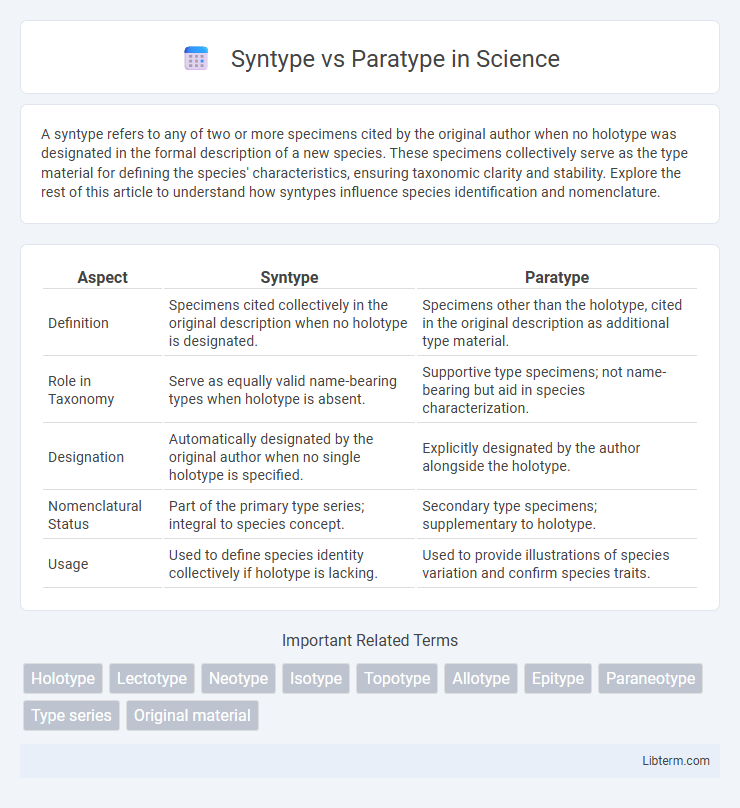A syntype refers to any of two or more specimens cited by the original author when no holotype was designated in the formal description of a new species. These specimens collectively serve as the type material for defining the species' characteristics, ensuring taxonomic clarity and stability. Explore the rest of this article to understand how syntypes influence species identification and nomenclature.
Table of Comparison
| Aspect | Syntype | Paratype |
|---|---|---|
| Definition | Specimens cited collectively in the original description when no holotype is designated. | Specimens other than the holotype, cited in the original description as additional type material. |
| Role in Taxonomy | Serve as equally valid name-bearing types when holotype is absent. | Supportive type specimens; not name-bearing but aid in species characterization. |
| Designation | Automatically designated by the original author when no single holotype is specified. | Explicitly designated by the author alongside the holotype. |
| Nomenclatural Status | Part of the primary type series; integral to species concept. | Secondary type specimens; supplementary to holotype. |
| Usage | Used to define species identity collectively if holotype is lacking. | Used to provide illustrations of species variation and confirm species traits. |
Understanding Syntypes and Paratypes
Syntypes are multiple specimens simultaneously designated as types when no holotype is specified in the original species description, serving collectively to define the species. Paratypes are additional specimens cited in the original description beyond the holotype, providing supplemental reference but not holding primary type status. Understanding the distinction helps clarify the taxonomic hierarchy and ensures precise species identification in zoological nomenclature.
Historical Context of Type Specimens
Syntypes historically served as multiple specimens collectively designated as the name-bearing types when no holotype was specified during original species descriptions in the 19th and early 20th centuries. Paratypes emerged later as supplementary specimens cited alongside a designated holotype to represent intraspecific variation, helping to clarify species boundaries in taxonomic revisions. This shift reflects the evolution of nomenclatural codes emphasizing a single name-bearing type for stability and precision in species identification.
Definition of Syntype
A syntype is any specimen cited in the original description of a species when no holotype was designated, serving collectively as name-bearing types. Paratypes are additional specimens cited alongside the holotype to demonstrate variation but do not have name-bearing status. Syntypes hold equal weight in defining the species' characteristics until a lectotype is selected.
Definition of Paratype
A paratype is any specimen cited in the original description of a species that is not the holotype but still helps define the taxon's characteristics. Unlike syntypes, which are multiple specimens collectively designated as types before a holotype is assigned, paratypes serve as supplementary reference material supporting the holotype's diagnostic features. Paratypes provide important morphological variation data that aid in understanding species limits and variations.
Key Differences Between Syntype and Paratype
Syntypes are multiple specimens cited in the original description of a species when no single holotype is designated, collectively serving as name-bearing types. Paratypes are additional specimens listed in the original type series that complement the holotype but do not hold name-bearing status individually. The key difference lies in syntypes forming the original type series with equal status, whereas paratypes are supplementary and support the holotype's identification without serving as primary name-bearers.
Role of Syntypes in Taxonomic Classification
Syntypes serve as multiple specimens collectively representing a species when no single holotype is designated, providing a foundation for taxonomic identification and comparison within biological classification. They ensure taxonomic stability by capturing the variability of a species, allowing researchers to refer to any syntype for species verification or revision. In contrast, paratypes are supplementary specimens cited alongside the holotype, serving to illustrate species variation but lacking the primary reference role held by syntypes in cases without a holotype.
Importance of Paratypes in Species Descriptions
Paratypes serve as essential reference specimens alongside the holotype, providing supplementary morphological data that support species descriptions and enhance taxonomic clarity. The inclusion of paratypes helps capture intraspecific variation, ensuring robustness and accuracy in distinguishing new species. Unlike syntypes, which collectively represent a species initially without a designated holotype, paratypes complement the holotype by reinforcing diagnostic features and aiding future taxonomic revisions.
Selecting and Designating Type Specimens
Syntypes are multiple specimens collectively designated as the name-bearing types when no holotype is specified, requiring careful selection to stabilize taxonomy. Paratypes are additional specimens cited in the original description, supporting but not defining the species name, useful for understanding variation within the taxon. Selecting and designating a lectotype from syntypes or recognizing paratypes ensures clarity in species identity and nomenclatural precision.
Challenges in Identifying Syntypes and Paratypes
Identifying syntypes and paratypes presents challenges due to overlapping characteristics and historical labeling inconsistencies in taxonomic collections. Syntypes are original specimens collectively used when no holotype was designated, complicating precise species identification without consensus on individual specimen roles. Paratypes, designated as supplementary specimens in species descriptions, require careful verification against original descriptions to avoid misclassification and ensure accurate taxonomic clarity.
Implications for Taxonomy and Nomenclature
Syntypes are multiple specimens cited collectively as types when no holotype was designated, potentially leading to ambiguity in species identification and naming consistency. Paratypes are additional specimens cited alongside the holotype that help define variability within a species, contributing to clearer taxonomic delineation and classification. The distinction impacts nomenclatural stability, with syntype sets often requiring later lectotype designation to resolve taxonomic uncertainties.
Syntype Infographic

 libterm.com
libterm.com